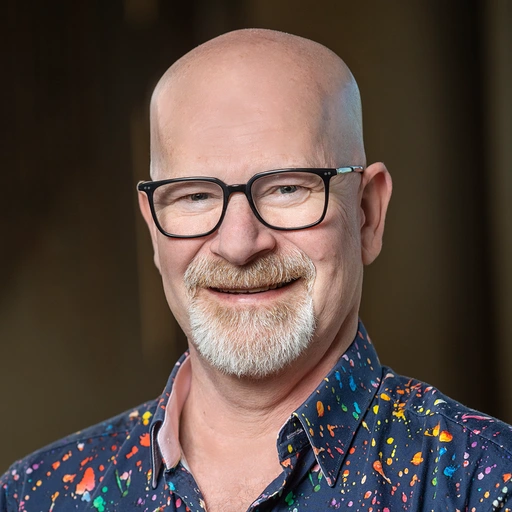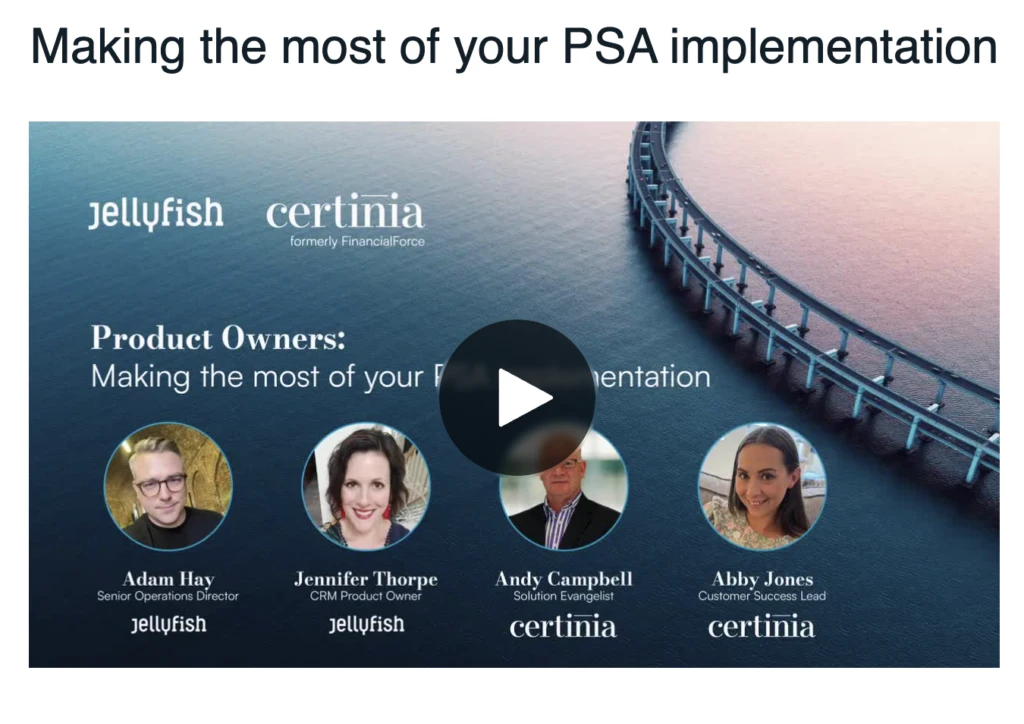You’ve implemented your Professional Services Automation (PSA) platform – what’s next?

Q: As the ‘owner’ of the Certinia PSA solution at Jellyfish, what are the key structures that you need to have in place?
Adam: There are four key structures that all product managers need to consider. The first is some form of centre of excellence. This should act as the place where people can go when they need information or advice. The second thing is that you have some form of user group – a forum for business that represents all the main stakeholders across the organisation. We should have regular meetings with this group to help us understand what their priorities are, what we should be working on, and also to vet the ideas that people on their team come to us and tell us about.
The third thing is that, between the end users and the central operations team, there needs to be a mechanism for gathering and validating new requirements and prioritising any activities. This provides a framework that allows product managers to decide best where to expend their energy and their efforts. The fourth and final piece in the jigsaw is to bring all those different bits together in some form of architectural perspective. For instance, at Jellyfish Jen looks after everything Salesforce related, whilst I look after Certinia – but we shouldn’t act independently. Instead, product owners should come together to take a business architectural view, which brings everything together in one place.
Q: You talked about having a group of champions. It’s all very well and good for this group to say “here’s the decision we’ve made”, but what role do they play in ongoing communications? Are they responsible for communicating that with the user groups they represent?
Jen: Absolutely. For example, what we’ve done with some recent process changes and new functionalities is to reach out to the champions and say “Hey, can I get a few minutes to speak at one of your standing meetings”. This gives us the opportunity to speak to them again, reinforce the relationship and reiterate where to go to find out more information. It’s really good to leverage the group this way, especially since it’s led by capability leaders. People are going to be much more receptive to listening if it’s coming from their own leadership, not someone from the central operations team.
These groups tend to meet regularly. For example, with Salesforce, the biggest groups that represent the majority of users are our growth, sales, and client management teams, which have regular standing monthly meetings.
Adam: We also bring the individual representatives within the champions group together as a whole to discuss how they’re feeling about the process. It gives them the chance to communicate the business challenges they’re having within their internal group and how Salesforce or Certinia can help them to solve this. This group would include individuals from sales and growth, client management, project management, and finance departments.
It is really important that this communication is bidirectional. It’s not just about our outputs as the operations group, but also understanding what challenges others are facing and if they represent the same challenges that we’re hearing about at a higher level. And, in most cases, they do.
Q: How do you manage the new initiatives that come out of Salesforce? How proactive are you in seeing what’s coming and how they might be applied across included within your products?
Jen: Prior to any upcoming release, our Salesforce and Certinia account teams will share the new release notes with us. This allows us to understand the new capabilities, get our hands on it in the sandbox, and evaluate what’s coming up and how we could apply the new functionalities. Sometimes there’s a lot, and other times there is very little for us to use. Either way, this does give us the opportunity to give our teams visibility about the new functionality before it’s been released, then we can get our hands on it and establish whether it’s something that would be beneficial for us. We can then consider how and when we will make the changes in the business.
On occasions when we know there’s a big project launch coming up, we might hold off on developing our own capabilities ourselves. For example, we wouldn’t want to develop our own customisation if the same thing is already on the product roadmap and likely to be part of the standard delivered product within the next six months from now. So we do have that visibility into the new initiatives.
Adam: The nice thing here is that Certinia and Salesforce are aligned in terms of the kind of releases they put out, which definitely helps us. What we’re aiming to do is constantly strive for improvements. For instance, it’s great that we have launched the PSA platform, but it doesn’t just stop there. It has to go through continuous improvement, we must receive user feedback and collect that information, and requires us to do our homework with the product to make sure that we can answer any questions to say, “yes – we can do that right away”. It’s a continuation, making sure that the process is moving in the right direction, even after implementation.
Q: What exactly is it that you need from your vendor and how important is the relationship that you develop with them?
Adam: We essentially view our vendors as an extension of our business. We need to know that we can have access to what the vendor is offering and work with them to make a difference in our business. As product owners, this means that Jen and myself have quite a large-scale responsibility from an internal PR perspective to make sure people know who you are and what you’re responsible for, as well as the leverage you have in being able to bring solutions. This is essentially what it all boils down to – making sure we’re able to leverage this through our relationships.
Q: How much engagement do you have with others in the broader Salesforce community? Not just within Jellyfish, but other Salesforce customers – in the media industry, for example?
Jen: I belong to a couple of user groups locally, including a Women in Technology group. That’s one thing I really do like about Salesforce – the fact that the community is very active and very willing to help each other out. And I use those groups to discuss what challenges we’re facing, what I think the solution to this may be, before asking other members of the group if anyone else has done this. Usually, the chances are that someone has done this before, so it is a great source of information and I would actively recommend other people to get involved.
Q: The role of a product owner is that you need to be a bit of a project manager, as well as a facilitator. But what role do other teams play in the process?
Adam: It’s not just about Jen and me, as product owners – it’s very much about our project managers, who help us to support both platforms, making sure that we’re running through our development sprints in a manageable way, prioritising them, and ensuring we’re able to deliver these enhancements to the business.
There’s also our admin team, who actually make this happen. Essentially, we’re telling them what we need, and they’re coming back to us and letting us know how we actually go about doing it. There is a plethora of different things that we’re all responsible for within the organisation. Whether they fall under the responsibility of product owners, project managers, or the admin team, there are situations in which they collide. In this event, it’s about making sure that you are working effectively together as a unit, that you’re on the same page, and that you’re all following the same vision. This is definitely something we have within Jellyfish.
Q: What is one last piece of advice you’d have for a product owner?
Adam: Understand as much as possible about what it is that you’re managing. Work closely with your vendor to really understand the product, what it can do and how it can be used. Know the product. Work with the product and actively engage with the vendor’s product development team, it will be to your mutual advantage.
Jen: Being a product manager can be a really fulfilling job, but there are moments when you can feel a bit stuck in the middle between different competing positions. When that happens don’t take things personally! As long as you keep in mind what the goals of the organisation are, and what needs to be done to achieve them, that’s what you should focus on and that is what drives success.
